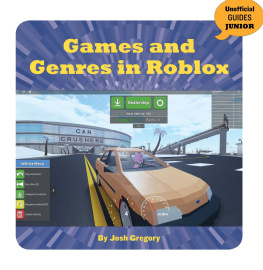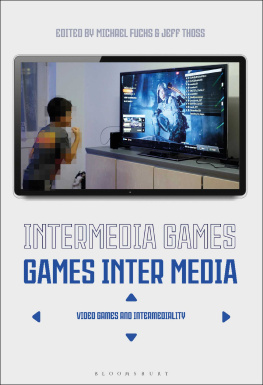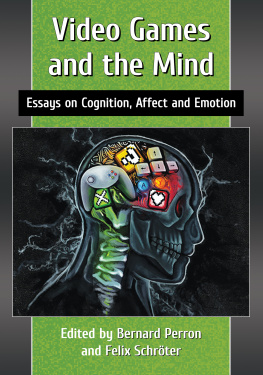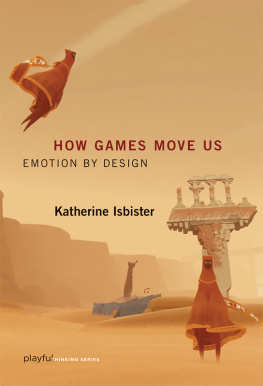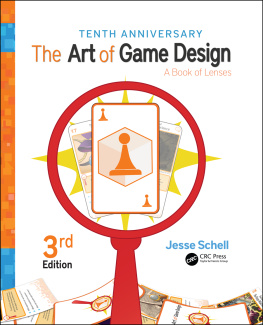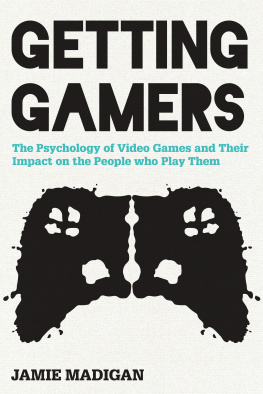Playful Thinking
Jesper Juul, Geoffrey Long, and William Uricchio, editors
The Art of Failure: An Essay on the Pain of Playing Video Games, Jesper Juul, 2013
Uncertainty in Games, Greg Costikyan, 2013
Play Matters, Miguel Sicart, 2014
Works of Game: On the Aesthetics of Games and Art, John Sharp, 2015
How Games Move Us: Emotion by Design, Katherine Isbister, 2016
How Games Move Us
Emotion by Design
Katherine Isbister
The MIT Press
Cambridge, Massachusetts
London, England
Katherine Isbister
All rights reserved. No part of this book may be reproduced in any form by any electronic or mechanical means (including photocopying, recording, or information storage and retrieval) without permission in writing from the publisher.
This book was set in Stone Sans Std and Stone Serif Std by Toppan Best-set Premedia. Printed and bound in the United States of America.
Library of Congress Cataloging-in-Publication Data is available.
ISBN: 978-0-262-03426-5 (hardcover)
eISBN: 978-0-262-33324-5
10987654321
This book is dedicated to my stepfather Anthony Falcone, who has been an enduring and devoted fanever willing to lend an ear, send a reference, and in general cheerlead the myriad efforts that are necessary to get such a project done. And also, to my Ph.D. advisor Clifford Nass, a brilliant, enthusiastic mentor who is sorely missed.
On Thinking Playfully
Many people (we series editors included) find video games exhilarating, but it can be just as interesting to ponder why that is so. What do video games do? What can they be used for? How do they work? How do they relate to the rest of the world? Why is play both so important and so powerful?
Playful Thinking is a series of short, readable, and argumentative books that share some playfulness and excitement with the games that they are about. Each book in the series is small enough to fit in a backpack or coat pocket, and combines depth with readability for any reader interested in playing more thoughtfully or thinking more playfully. This includes, but is by no means limited to, academics, game makers, and curious players.
So, we are casting our net wide. Each book in our series provides a blend of new insights and interesting arguments with overviews of knowledge from game studies and other areas. You will see this reflected not just in the range of titles in our series, but in the range of authors creating them. Our basic assumption is simple: video games are such a flourishing medium that any new perspective on them is likely to show us something unseen or forgotten, including those from such unconventional voices as artists, philosophers, or specialists in other industries or fields of study. These books are bridge builders, cross-pollinating areas with both new knowledge and new ways of thinking.
At its heart, this is what Playful Thinking is all about: new ways of thinking about games and new ways of using games to think about the rest of the world.
Jesper Juul
Geoffrey Long
William Uricchio
Acknowledgments
The writing of this humble tome took a surprising amount of time and effort. Thanks to the Humboldt Foundation, and Marc Alexa of Technische Universitt Berlin, for supporting me through multiple summers of writing. Thanks to the CASBS Center at Stanford University for supporting me during the sabbatical year that brought the writing all the way to completion (and to the Annenberg Fund for fellowship support). While at Stanford, I benefited from presenting and discussing these ideas with students of Michael Bernstein and James Landay in the HCI program, with attendees of the Games and Interactive Media lecture series put together by Henry Lowood, Ingmar Riedel-Kruse, Sebastian Alvarado, Paul Zenke, Chris Bennett, and colleagues; with attendees of the Media-X annual conference hosted by Martha Russell; with Karin Forssell and her students in the Learning, Design, and Technology masters program; and with the fabulous Wendy Ju. There were of course lively conversations with fellow CASBS fellows, who gave me much sage advice, and a fun title brainstorm with Scott Bukatman.
Thanks to New York University for providing me a scholarly home base over these years. The Game Innovation Lab was a wonderful incubator for research on games and emotion. Terrific colleagues from the Game Engineering group in the Computer Science Department and from the NYU Game Center influenced how I think about games and what they do for us. Discussing games as a cultural form with Frank Lantz, Eric Zimmerman, Jesper Juul, and other early Game Center community members particularly shaped my own thinking about the framing of this book.
Much appreciation to those who read over drafts and discussed the ideas herein with me: Kaho Abe, Gabriella Etmektsoglou, Clara Fernandez-Vara, Michael Mateas, Andy Nealen, Syed Salahuddin, Fred Turner, Sharra Vostral; and the graduate students who I have had the privilege to work with on these themes over the last few yearsXiaofeng Chen, Jonathan Frye, Chelsea Hash, Michael Karlesky, Shoshana Kessock, Suzanne Kirkpatrick, Elena Mrquez Segura, Edward Melcer, Shilpan Patel, Toni Pizza, Rahul Rao, Holly Robbins, Ulf Schwekendiek, Raybit Tang, and Kong Tsao (and many more who I inadvertently omitted, Im sureplease forgive me!). And thanks to Chrystanyaa Brown and Chris DiMauro for keeping the lab going so we could all build great research games there.
Thanks to those in the game development community who have explored the intersection of game design and emotion with their games, writings, and public presentations. In particular, the work of Jenova Chen and Nicole Lazzaro has been influential to me, and their efforts are cited in these pages.
Thanks to the series editors and those at the MIT Press who shepherded this book along, in particular Jesper Juul, my erstwhile colleague at NYU and my patient editor, and Doug Sery, who has been a tireless champion of thoughtful writing on games. Thanks to Christine Larson for her adept amendment of my turgid academic tone, and to Luke Stark for tidying references and gathering image permissions. Thanks to Kristina Hk for hosting me and egging me on while I made and uploaded the final changes to the manuscript.
Finally, on the home front, a shout-out to my husband, Rene Netter, who is always game to listen to an idea that trails me home from work, and to my daughter Nona Lily Netter, who keeps my life playful.
Introduction
Games have reached a watershed moment in our culture. Pretty much everyone now accepts the fact that games are a big deala huge revenue generator with sales in the same league as film and books, and a daily presence in the lives of millions of people in one form or another. We collect games in museums and read about them in high culture venues like the New York Times. But the public conversation around games isnt as nuanced and well informed as it could be, and really, as it needs to be.
To have a rich and meaningful discussion about how games fit into our lives, how they work on us as human beings, we need to get beyond shadowboxing with a monolithic notion of games, and delve into the elements that make up the game experience in all its facets. We would never lump Hollywood action films, Sundance winners, and nature documentaries together when discussing the impact of film. We see these as different kinds of works, using different techniques, for different audiences, to different ends. We dont hold films from each of these categories to the same standards as the others. We wouldnt assume Hollywood films represent the full emotional register of filmmaking, and we dont expect every art house film to save the rain forest.
Next page


